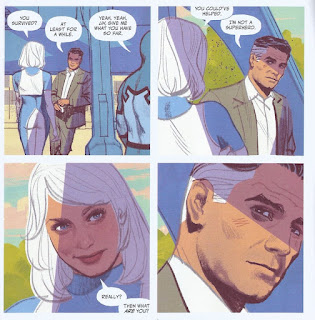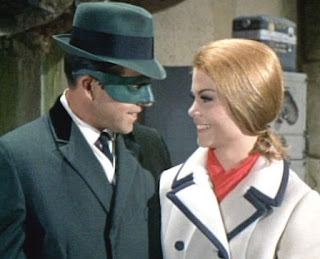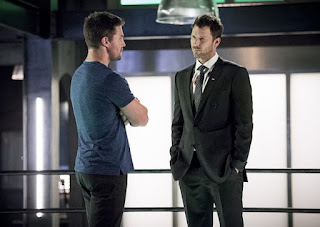Pick of the Brown Bag
February 25, 2022
by
Ray Tate
Welcome to part two of the Pick of the Brown Bag's investigation into Christopher Chance, alias the Human Target. Yes, you can also still find me on Twitter: #PickoftheBrownBag.
Tom King and Greg Smallwood team up to grant some respectability to the hit and miss DC Black Label brand.
King's excursion blends two different genres beautifully: the detective novel and the science fantasy of the superhero. In a first person narrative Christopher Chance discovers his time is limited.
The nature of the characters and the placement of Christopher Chance distinguishes his latest and perhaps last case from even the above average dead man walking mystery.
DC's Black Label brand gave King the excuse to cut Christopher from the superhero world of DC. Instead, he plants him right into it, which is historically proper.
The first book of The Human Target sets up the premise and introduces you to Greg Smallwood's artwork. Smallwood is a vital part of the book's success. His illustration, which looks like it's searching for its lost 1940s private eye novel cover home, suits the tradition of Christopher Chance's visual history of clean comic book artwork.
As Christopher lays "dying" his mind turns back the clock to when he accepted the Lex Luthor assignment and first partook of the poison. Of special note, Christopher does not remember getting into his car, driving and crashing.
Also notable, Lex Luthor calls the Justice League when his people find Christopher. It's possible the poison guaranteed Christopher wouldn't travel far off the Luthor grounds. It's equally possible that Luthor is setting up Christopher Chance to be bait, to lure the Justice League into a Byzantine scheme, quoting the Blue Beetle in Human Target book four.
However because of Christopher Chance's familiarity with the superhero world, Luthor very well may be on the up and up and called the League because he felt that Christopher was one of them. As a result of Luthor's call, Christopher ends up under the care of the original Dr. Mid-Nite.
Here again, King uses the Black Label to his advantage. He doesn't need to explain Dr. Mid-Nite being the original. He doesn't need to go into a footnote about how Dr. Mid-Nite and the rest of the Justice Society ended up alive and well. They just did.
This technique furthermore agrees with King's overall attitude when writing superhero books. In Batman he recovered the entire chucked history of Batman and Catwoman. So, seeing the Golden Age Dr. Mid-Nite hale and hearty in King's latest should almost be expected.
Dr. Mid-Nite proves he hasn't lost any of his skills. He determines the nature of the poison. He also points Christopher into the direction of the most likely and most unlikely suspects, the Justice League.
I'm not absolutely sure where the Bwa-Ha-Ha-Ha Justice League of the nineties lands in current DC continuity. With Black Label I don't need to. For this series, they existed.
King expresses a familiarity with the Giffin/DeMatteis/Maguire Justice League throughout The Human Target. That's great for fans of the heroes as well as followers of what appears to be a fair-play mystery. Meaning, the motive for killing Lex or Chance must make sense and must agree with each suspect's personality.
In book two, The Woman arrives to complicate the detective's linear search for justice, or to help Christopher find the culprit. I use the phrase The Woman quite purposely. The femme fatale, the duplicitous love interest of the detective first emerged in the case files of Sherlock Holmes.
Before Irene Adler, female characters in crime fiction were either good or either evil. Never a complex blend. All of the dames that betray Sam Spade, Philip Marlowe or have a change of heart and rescue Travis McGee and Lew Archer owe a debt to Doyle. Surprisingly, Ice is The Woman in The Human Target.
Ice of the Justice League strongly derives from Icemaiden, a character created by E. Nelson Bridwell and Ramona Fradon, for the Super-Friends comic book series.
Because of an error regarding Icemaiden's secret identity, the Justice League superhero grew ever more distinctive from her source. Other writers and artists continued to diverge Ice's and Icemaiden's history as well as their appearance and behavior.
King takes a deep dive into Ice's history. A lot of it completely unfamiliar to me. I knew Ice died...somehow...having seen her as a ghost in a Justice League annual and witnessing a despondent Fire beg for J'onn to shape-shift into the form of her old friend. Occurring in The Martian Manhunter.
Ice in The Human Target relates two different histories--one mythical, which I vaguely remember, the other terrestrial; nope. She identifies the old Justice League Detroit villain Overmaster as her slayer. Drawing a blank.
Overmaster also somehow colluded with Lex Luthor, which I suspect is King's artifice. Therefore most likely a red herring to give the Justice League motive to kill Lex. Sorry. Still not sold on any of the League poisoning Lex Luthor.
The entirety of book two offers the kind of melancholic mood one habitually finds in the classic private eye novel. It's peculiar how Ice of all people works so smoothly as a female catalyst. She at once conveys world weary wisdom, the image of the injured party and the enigma but never abandoning her bwa-ha-ha-ha origins. As a character piece, book two of The Human Target is hard to beat.
Book three splits between Booster Gold and Guy Gardner. Guy Gardner takes on the role of the "heavy." He doesn't like Christopher Chance warming up to Ice, his ex.
Part of what Guy does in book two answers the need for the detective to be beaten up in the novel. The difference lies in Guy's independence. Normally, the "heavy" is the lieutenant of the main crook. Here, Guy acts on his own. The Green Lantern element furthermore takes his harassment out of the detective genre.
Guy's appearance, his behavior, his relationship to Ice all consolidate into a prime suspect, especially given the Lantern rings being subject to a Three Laws of Robotics code. In other words, the rings cannot directly harm a life form even if the bearer wills it.
If one harbors a grudge, but one cannot use his magic power to kill, poison may seem like a great idea. Guy is also one of three people who first knew of Lex Luthor's hand in Overmaster's scheme.
These facts draw Fire and Ice to the forefront of the suspect list. Yet Fire and Ice could have kiled Lex in so many overt and subtle ways. Guy not so much.
Yet I doubt. Guy Gardner simply isn't smart enough to concoct such a scheme. To emphasize, Christopher Chance demonstrates how easily it is to outwit Guy. The scene also depicts that though Chance is on a mostly cerebral quest, the comic book isn't above action.
Action-packed anything is often looked down upon by the snobbish. I am certainly not one of those people.
The Booster Gold investigation goes as one may expect. Booster Gold is hilarious.
That reputation springs purely from Justice League, where Booster and Blue Beetle became the best of friends and a comedy double-act. Before the League, Booster was a self-serving jackass out to upstage Superman. Booster stole future tech to travel back into the past to become famous. I can easily see that Booster poisoning somebody.
In Human Target, Booster is opening up one of what he hopes to be a bagel franchise.
It's preposterous to suggest Booster has the brainpower, motive or want for revenge. Furthermore, he would somehow need o ditch his robot companion Skeets. Same reason as Guy's ring. King in fact glosses over Booser. Presenting him as a minor suspect, but he includes one interesting fact. Booster cannot remember where he has been. That could be simply Booster, or it may be a symptom of a grander solution to this mystery. Overmaster controls minds. Mind control will play a part in Human Target book five. Booster also apparently could have obtained the ingredients to the poison, which seems to obvious a tell from King. So, naturally, I'm dismissing it.
In the fourth book, Christopher and Ice go to question the Blue Beetle. King and Smallwood really do a number on the Blue Beetle. With Kirbeyesque abandon, they paint a striking picture.
The Blue Beetle is a credible, albeit small potatoes, super-hero and a successful technology tycoon. They also add a dash of Green Hornet, to Ted Kord's pursuits. Like Lenore "Casey" Case, his secretary Nancy knows his secret.
Based on a 1939 public domain superhero, Ted Kord's Blue Beetle originated with Steve Ditko in Charlton Comics back in the sixties. DC bought the Charlton characters when the company dissolved. Though Blue Beetle features in Crisis on Infinite Earths, he made his biggest splash in Jon Ostrander's and John Byrne's Legends where the new Justice League formed.
Whereas Booster Gold isn't smart enough to pull off the murder of Lex Luthor, Blue Beetle is almost too smart to do it. This is a stark contrast to the way Keith Giffin and J.M. DeMatteis portrayed Beetle in Justice League, but gibes with what he is supposed to be.
Smallwood presents Blue Beetle's intellect through his technology, and King depicts the Beetle's absurdity through the same. Why does Ted Kord need some kind of replicator to don the Blue Beetle suit?
No idea. Even if the suit's made of some kind of special fabric, the process seems superfluous but also the kind of comical quirkiness that you expect from a goofy character like the Blue Beetle. Book four of Human Target is so off-kilter due to the Blue Beetle that it really needs to be accompanied by a mouth harp.
Beetle's tech knowledge originally described his purpose with the Justice League. He was their pilot, and they traveled in Blue Beetle's Bug.
The original Justice League of America didn't have transport vehicles like the Quinjet of the Avengers. So many of the members flew under their own power they didn't need such transport. You would often see Batman and/or Black Canary riding on a Green Lantern constructed platform.
In the Bug, Beetle transports Christopher and Ice to various crime scenes dotting the country. Blue Beetle doesn't have a territory like Batman. He simply goes where the action is. Although the action is very low level danger in comparison to the threats he and Ice faced in the Justice League.
Ice and Beetle team up, and it's here that Christopher notices something about the partnership. This doesn't play into the mystery. Rather it remarks on just how incredibly powerful almost every superhero can be given the specs of those powers.
I frequently point out that Dazzler, created as a business deal with a rock singer, is incredibly, stupidly powerful. All she does is use her mutant powers to create light shows and blind bad guys, but if she wants to, she can transform sound into a laser beam and bore a hole through the moon. It's ridiculous.
As he teams with Ice, Beetle dissects the reasons he could have killed Lex Luthor and the reasons why Lex Luthor may be behind the whole scheme.
Throughout the Human Target, King predicts the reader's suspicion. He brings up Lex as a suspect quite surreptitiously, but often enough to discount the labyrinthine thinker. The biggest problem I have with Lex is motive. I can only think of one possibility.
Lex in fact detected the poisoned coffee, determined the nature, but couldn't deduce who in the League poisoned him. So he set up Christopher Chance to do the legwork for him. In this scenario, he may have even exploited the gunman that Christopher succeeds in stopping. Perhaps even calculating how much poison Christopher would have thrown up after being shot. Thus, Lex uses Christopher as a stalking horse to quietly cut down the League's murderous member and free himself from any possibility of payback, and yet...
Book five, the most recently published of the series, draws Christopher face to face with the Martian Manhunter.
The Martian Manhunter began his career in 1955's Detective Comics. He arrived on earth by accident.
There is a lot of things going on in this chapter of The Human Target. Some I cannot reveal. What I can say is that the woman on the cover is not Diane Meade.
Introduced in 1957, Diane Meade is an "emergency police woman"--no idea--and the Commissioner's daughter. She fully joins the Martian Manhunter cast in 1960.
Though not Diane Meade, the woman on the cover is steeped in DC history and exemplifies King's ability to create complex characters. She exists in Christopher's past.
Other scenes in the book, demonstrate King's ability to add depth to already established characters and use the Black Label brand for the sake of legitimizing plot elements that could only be hinted at in a mainstream title.
This juxtaposition of scenes added to the DC history cements King's determination that Christopher Chance is part of a superhero universe. Indeed, he must be.
For those following the mystery, this book is the big one. The one where King divulges a lot of clues or generates devilish subterfuge.
It sure looks like the guilty party reveals himself, but I don't know. The revelation seems way too easy. Notable, the guilty party doesn't explicitly admit to the crime. In addition the stream of consciousness is somewhat unreliable. How do we know the visuals we see haven't been influenced by Christopher's own experience?
Five books in, and I really don't know who poisoned Christopher Chance. My best guess is still Lex Luthor. However, who poisoned the coffee in the first place?
I'm thinking G'nort, the hapless screwup dog Lantern. Contaminated with the radioactive poison, he fell into the water used for Lex Luthor's coffee, or something like that. I can't envision any of the Justice League raw enough to poison Lex Luthor. None have a score to settle with Christopher Chance. I also cannot help but wonder why King and/or Smallwood included G'nort among the heroes. G'nort was at best a mascot, and King knows that. They depict for a reason.




















































